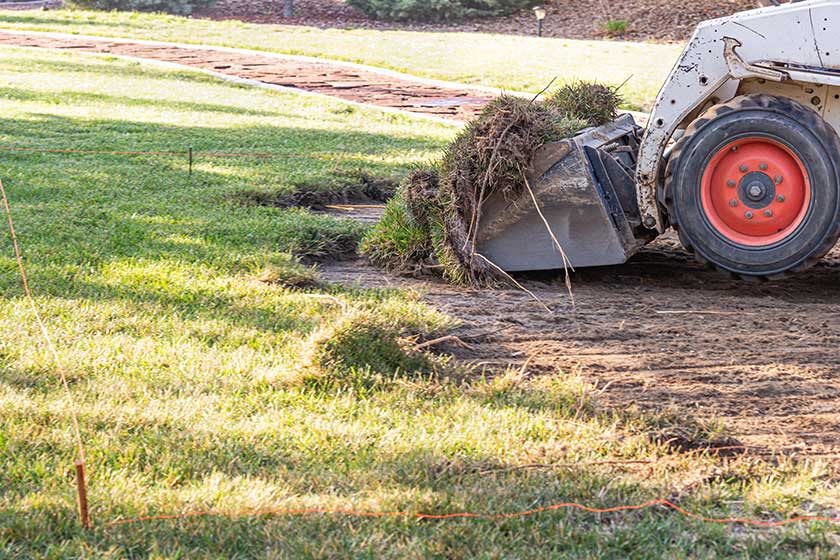Land grading is a vital aspect of landscaping that guarantees proper drainage, prevents water pooling, and enhances the overall functionality of the land. This process involves leveling and reshaping the surface of the soil to create a stable foundation for construction or landscaping projects. Effective land grading helps to improve water flow, reduce erosion, and prepare land for future use.
Here are practical tips to make sure the process is smooth, efficient, and provides long-lasting results.
Plan Land Grading Project Before Starting Work
A successful land grading project begins with detailed planning. Proper planning allows you to identify any potential challenges, allocate resources effectively, and determine the grading scope.
Without a solid plan, grading work can quickly turn inefficient and lead to costly mistakes or delays. Take time to map out the area, outline the specific goals, and consider the desired land slope and water flow requirements.
Understand Local Regulations for Land Grading Permits
Before beginning any grading work, familiarize yourself with local regulations related to land grading permits.
In many areas, permits are required to alter the land’s topography, especially for large-scale projects. These permits are designed to confirm that grading work is done safely and in compliance with zoning laws, environmental protection standards, and water management requirements.
Obtaining the proper permits helps avoid potential legal issues and makes sure your project meets all local regulations. It is important to research your city or county’s specific land grading laws to stay compliant and avoid fines or project delays. Consulting with local authorities and reviewing zoning codes can provide clarity on what is required before starting the work.
Assess Soil Type and Drainage Needs for Grading
Before proceeding with grading, assessing the soil type is key to understanding how it will react to grading. Different soil types have varying drainage properties that impact how water flows across the land. For example, sandy soil drains faster than clay soil, which may require adjustments to your grading plan to guarantee proper water flow.
In addition to soil type, drainage needs should also be thoroughly assessed. Proper drainage prevents water from pooling or causing erosion, which can damage the grading work over time.
Make sure that the land is graded to direct water away from structures and low-lying areas. A well-planned drainage system is key to maintaining the integrity of the grading and protecting the land for future use.
Choose the Right Equipment for Efficient Land Grading
Selecting the right equipment plays a significant role in the efficiency of a land grading project. The equipment you choose depends on the size and complexity of the grading work, as well as the terrain.
Smaller projects may require tools such as shovels, rakes, and leveling instruments. Meanwhile, larger projects demand heavy machinery like bulldozers, graders, or backhoes.
Using the correct equipment speeds up the grading process and guarantees precision. Heavy machinery can move large volumes of earth quickly and provide a more even surface. However, it’s important to choose equipment that fits the scale of your project to avoid unnecessary costs or inefficiencies.
Hire Experienced Professionals for Complex Grading Projects
For complex grading projects, hiring experienced professionals makes sure the work is done correctly and efficiently. Professionals bring expertise in assessing soil, managing water flow, and operating heavy machinery. They also understand the necessary local regulations and can help with obtaining permits.
Hiring experts can save you from making costly errors that might occur due to inexperience or poor planning. Professional contractors have the knowledge to deal with challenging grading conditions and will help you achieve the best results.
For intricate or large-scale grading projects, relying on professionals guarantees that the work is completed to a high standard and within the given timeframe.
Clear Debris and Vegetation Before Grading Begins
Clearing debris and vegetation is an important step before starting land grading. Removing obstacles such as rocks, trees, or shrubs makes sure that the grading work is not hindered by obstructions. It also helps create a smoother surface and allows for more accurate grading. In addition, clearing vegetation prevents roots from interfering with the grading machinery and improves soil quality.
Taking the time to clear the land reduces the risk of damage to your equipment and speeds up the grading process. Once the area is free from debris, the land is ready to be leveled and reshaped according to the project requirements.
Establish Proper Slopes to Prevent Water Pooling
Establishing proper slopes during land grading is necessary to direct water away from structures and prevent pooling. Water pooling can lead to erosion, foundation damage, and poor drainage. The correct slope makes sure that water flows freely across the land and into designated drainage areas, helping maintain the integrity of your grading work.
Carefully calculate the slope requirements based on the size and purpose of the project. A slight slope (around 1-2%) is often sufficient for most residential projects. However, larger commercial projects may require steeper slopes to manage greater amounts of water. Accurate slope design is a key component in achieving a long-lasting grading solution.
Use Erosion Control Measures During Grading Process
Loose soil moves easily, causing erosion that weakens foundations and disrupts drainage. Controlling erosion during land grading keeps soil stable, prevents sediment runoff, and maintains project integrity.
Silt fences, straw wattles, and erosion blankets hold soil in place while vegetation and mulch provide long-term stabilization. Without these measures, heavy rains wash away newly graded areas. This can lead to uneven surfaces and potential damage.
Grading work exposes bare soil, making it vulnerable to shifting. Installing temporary barriers reduces soil displacement, while seeding stabilizes the ground over time. Water diversion techniques, such as swales and retaining walls, manage runoff and prevent washouts. Proper erosion control protects the grading investment and secures lasting results.
Monitor Weather Conditions to Avoid Grading Delays
Unexpected weather disrupts land grading projects by softening soil, increasing erosion, and delaying work. Dry, stable conditions create the best environment for grading. Meanwhile, excessive moisture causes instability and compaction issues. Rain saturates the ground. This makes it difficult to achieve smooth, level surfaces, while extreme heat hardens the soil, complicating excavation.
Checking forecasts before starting work helps avoid setbacks. Scheduling grading during dry periods prevents rework and maintains efficiency. Wind conditions also affect dust control and erosion, and require adjustments to keep soil in place. Adjusting plans based on weather patterns minimizes disruptions and allows for a more effective grading process.
Compact Soil Properly to Guarantee Stable Foundation
Loose soil creates an unstable surface that shifts under pressure. Compacting soil during land grading increases density, improves load-bearing capacity, and prevents future settling.
Proper compaction reduces the risk of cracks, sinkholes, and structural failures in landscapes, driveways, and building foundations. Skipping this step leads to uneven ground, erosion, and costly repairs.
Compaction methods vary based on soil type. Clay requires kneading action, while sandy soil compacts well with vibration. Layering and compacting soil gradually produce the best results. Testing density throughout the process ensures a firm, stable base for long-term durability.
Check for Underground Utilities Before Grading Starts
Grading without inspecting underground utilities causes costly damage and safety risks. Gas lines, water pipes, and electrical cables lie beneath the surface. This makes it important to identify their locations before excavation. Striking a buried utility disrupts services, creates hazards, and requires expensive repairs, delaying progress.
Utility marking services locate underground lines before grading begins. Mapping these connections prevents accidental damage and secures safe digging. Adjusting grading plans around utilities avoids interference and protects infrastructure. Careful assessment before excavation ensures smooth operations and prevents unexpected setbacks.
Balance Cut and Fill to Minimize Material Waste
Uneven terrain often requires soil redistribution. Efficient land grading balances cutting high areas and filling low spots to reduce the need for extra material. This method lowers costs, minimizes hauling requirements, and guarantees an even surface without excessive waste.
Planning the cut-and-fill process improves efficiency. Analyzing the landscape determines how much soil needs removal and where it should be placed. Keeping adjustments minimal reduces environmental impact and labor expenses. Using on-site soil instead of importing or disposing of excess material optimizes grading efforts.
Implement Proper Drainage Systems After Grading Work
Water pooling damages landscapes, weakens foundations, and causes erosion. Installing drainage solutions after land grading prevents standing water and directs runoff away from structures. Slopes, trenches, and drain pipes control water movement–reducing saturation and soil displacement.
Poor drainage leads to uneven surfaces, plant loss, and structural damage. Creating a grading plan that includes drainage prevents these issues. French drains, swales, and dry wells improve water flow, keeping land functional and dry. Proper drainage design preserves grading work and extends landscape longevity.
Inspect Graded Land for Accuracy and Smoothness
Rough, uneven ground affects landscaping, construction, and drainage. Checking surface levels after land grading confirms accuracy and prevents future issues. Low or high spots cause water retention, structural instability, and grading inconsistencies. This requires adjustments before project completion.
Surveying tools measure slope accuracy, ensuring proper water runoff and stability. Walking the site helps identify irregularities that may need correction. Making final adjustments before construction or planting ensures a polished, functional, and visually appealing result.
Maintain Graded Land to Prevent Future Erosion
Graded land shifts over time due to weather and natural settling. Regular maintenance prevents erosion, maintains drainage efficiency, and keeps surfaces stable. Monitoring slopes, reapplying stabilization materials, and addressing minor shifts early to avoid major repairs.
Planting grass or ground cover holds soil in place, while retaining walls and drainage systems manage water flow. Periodic inspections identify weak spots before they worsen. Keeping the land stable extends grading effectiveness and prevents costly rework.
Get Expert Land Grading Services in Scottsdale with Covenant Landscapes!
A smooth, well-prepared landscape starts with expert land grading services in Scottsdale. We level uneven terrain, improve drainage, and create a stable foundation for your outdoor space.
Our team guarantees precision, so your property remains structurally sound and ready for any landscaping project. As professional grading contractors in Scottsdale, we use top-tier equipment and proven techniques to deliver efficient results.
Contact Covenant Landscapes today for expert land grading solutions that set the stage for a flawless landscape!



